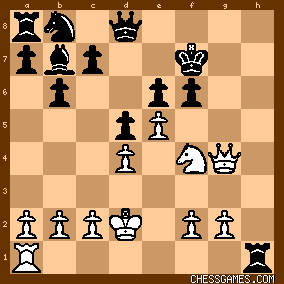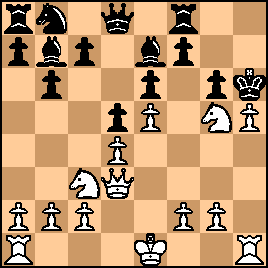|
< Earlier Kibitzing · PAGE 2 OF 2 ·
Later Kibitzing> |
| Jun-26-04 | | poolookoo: <Chessical> Thanks, I just overlooked on how the king would actually make an escape. How about a Rook sac at 14. ...Rxf6 |
|
| Jun-27-04 | | themindset: my crafty, at depth of 18:
depth=18 1/5 +1.05 11. ... Kh6 12. Qd2 Qe8 13. Nxe6+ Kh7 14. Nxc7 Qc6 15. Nxa8 Bxa8 16. O-O-O Bb7 17. h5 Bb4 18. h6 gxh6 19. Qf4 Bxc3 20. bxc3
Nodes: 3663382826 NPS: 53022 |
|
Jun-27-04
 | | Chessical: <poolookoo> From the stem game after: <14...Rxf6> 15.Nf4+ Kf7 16.Qh5+ Ke7 17.exf6+ gxf6 18.Qg4; Black appears to be completely lost. |
|
| Sep-07-04 | | akiba82: Does someone know which game was the first to feature the Greek Gift bishop sacrifice? |
|
| Jun-18-07 | | srinivas6195: i doubt was alexander fritz better or deep fritz 10 is better |
|
Dec-31-08
 | | Domdaniel: Other sources give a slightly different move order: 5.Bxf6 Bxf6 6.Nf3 0-0 7.Bd3 b6 8.h4 Bb7 9.e5 Be7 10.Bxh7+ [transposing back to the version here] This actually makes a little more sense for both sides. It also makes sense of Lasker's comment that ...Ba6 would have been better than ...Bb7 -- if white can play Bxh7+ at once, then it makes little difference where black develops his bishop, but if white has yet to play e5 then ...Ba6 threatens to exchange LSBs. |
|
| Feb-26-09 | | WhiteRook48: a human Fritz! This looks like a Rybka demolition (or a Fritz one) |
|
| Mar-02-09 | | WhiteRook48: I think that Alexander Fritz is better, judging from a game. |
|
Aug-18-12
 | | Phony Benoni: We may have an inaccurate score here. Sellman's column in the <Baltimore American> for August 12, 1883 gives this version: <1.e4 e6 2.d4 d5 3.Nc3 Nf6 4.Bg5 Be7 5.Bxf6 Bxf6 6.Nf3 0-0 7.Bd3 b6 8.h4 Bb7 9.e5 Be7 10.Bxh7+ Kxh7 11.Ng5+ Kg6 12.Ne2 Bxg5 13.hxg5 f5 14.gxf6 Rh8 15.Nf4+ Kf7 16.Qg4 Rxh1+ 17.Kd2 gxf6 
click for larger view18.Qg6+ Ke7 19.Qg7+ Ke8 20.Qg8+ Ke7 21.Qxe6+ Kf8 22.Rxh1 Bc8 23.Rh8+ Kg7 24.Rh7+ Kxh7 25.Qf7+ Kh8 26.Ng6#> 1-0 This version contains the opening transposition mentioned earlier by <Domdaniel> but the big divergence comes at the diagrammed position. This score has Fritz eventually reaching the finish given in our version, but going the long way round to do it. Which is correct? The long version is given also by the 1883 <British Chess Magazine>, p.298. Lasker did make errors in the scores of games on which he commented. For example, in his <Manual of Chess> he gave a different finish to the "Evergreen Game" (Anderssen vs Dufresne, 1852) than is found in other sources. Lasker's version is more accurate, which probably argues for the authenticity of the longer version--who would make up a weaker continuation? However, if my Bozo 0.5 computer is to be believed, neither 18.Qg6+ or 18.Qxe6+ are best move for White in the diagram. |
|
Aug-19-12
 | | Dethrin: <Phony Benoni>
There really is no coming back for black at this point, as 18.Rxh1, 18.Qxe6+, and 18.Qg6+ all lead to mate; almost every move is forced.18.Rxh1 Qf8 19. Rh7+ Ke8 20.Qh5+ Kd8 21.Nxe6+ Kc8 22.Rxc7# (18...Qg8 won't save Black after 19.Qxe6+ Kf8 20.Ng6+ Qxg6 21.Rh8+ Kg7 22.Qg8#) 18.Qxe6+ Kg7 19.Rxh1 Qf8 20.Qg4+ Kf7 21.Rh7+ Ke8 22.Qg6+ Kd8 23.Ne6+ Kc8 24.Rxc7# 18.Qg6+ Ke7 19.Qg7+ Ke8 20.Qg8+ Ke7 21.Qxe6+ Kf8 22.Rxh1 Nd7 23.Rh8+ Kg7 24.Rh7+ Kxh7 25.Qf7+ Kh8 26.Ng6# And on another note, 11...Kh6 would indeed keep black in the game. |
|
| Apr-23-16 | | zanzibar: Several biographers have already questioned the movelist: A Fritz vs J Mason, 1883 (kibitz #18) A Fritz vs J Mason, 1883 (kibitz #21) The German TB is online (see Calli), and this game is in it, of course: <TB G-2 p86/104>
It has the move order given by Dom:
<7.Bd3 b6 8.h4 Bb7 9.e5 Be7> and it indeed ends at 22...Bc8 with the comment
<Weiß setzt in 4 Zügen matt.> = <White mates in 4 moves> The Germans seemed fond of announcing mates to end games during this era. I think Sellman just decided to spell it out for the benefit of his readers (we've seen this before). I'd like confirmation about the Tpos in the opening, was that truly the order Lasker gave? |
|
| Apr-23-16 | | zanzibar: BTW- Does Lasker's book really contain the following sentence on p5? <"To try to understand its aspirations ... is a tribute to the genius of the white race."> In reference to the game of chess.
http://www.amazon.com/Laskers-How-P... |
|
Aug-31-18
 | | Honza Cervenka: <cg.com> There is a problem in PGN of this game. In my viewer I can see just first nine moves. |
|
| Aug-31-18 | | zanzibar: <Honza> maybe the last comment brace before the result should have a space after it, but I think that's just a stylistic wrinkle. SCID reads the PGN without complaint, and I can't really see anything wrong with it by eye. What viewer are you using?
And which move exactly goes wrong (i.e. White or Black)? (I'll try to switch to Olga and see if it is failing.... Ah yes, <Olga> goes wrong, hanging after Black's 9th move. Is this because both White's and Black's 9th move have a comment?) |
|
| Sep-01-18 | | Granny O Doul: I don't think "Greek gift" works as a name for the Bh7+ sac. If you refuse the "gift", you've lost a pawn in front of your king for nothing. |
|
| Dec-31-18 | | fkohn: The problem is that in the annotation to Black's ninth move the period is outside the brackets instead of inside. I have submitted a correction slip. |
|
| Jul-22-20 | | Chesgambit: Kh6 better than Kg6? |
|
| Apr-25-21 | | vonKrolock: Or 11...Kh6 12.Qd3! (Stronger than Lasker's suggestion) 12...g6 13.h5! 
click for larger view |
|
| Feb-05-23 | | generror: <Phony Benoni>: I have found a third version in Lasker's 1895 <Common Sense>. Compared with the version here, the 7th and 8th moves are inversed (i.e. <7.Bd3 b6 8.e5 Be7>). Then Black's 14th and 15th move are inversed (i.e. <14.gxf6 Kf7 15.Nf4 Rh8>. And the game ends with <18.Qg6+ Ke7 19.Qg7+ Ke8 20.Qg8+ Ke7 21.Qxe6+ Kf8 22.Rxh1 Kg7 23.Rh7+ Kxh7 24.Qf7+ Kh8 25.Ng6#>, similar to your version, but a move quicker. The score given here on CG is identical with the one given in his 1935 <Primer> (aka <How to Play Chess>). |
|
| Feb-05-23 | | generror: And the version given in Schallopp's 1884 tournament book is identical with Phony's Baltimore version, it just ends after Black's 22nd move saying "and White mates in 4 moves"). I find the move order of the original versions a wee bit more natural, and personally, I consider it to be the official version. I'm a huge Lasker fan, but I can imagine he would have had no big problems slightly editing the score for didactical or aesthetic purposes. In the end we'll never know, and it really doesn't change the game in any significant way. |
|
| Feb-05-23 | | generror: Finally I checked the <Deutsche Schachzeitung>, which lists the game in its September 1883 issue, and again it's identical to the tournament book and the <Baltimore American> version, i.e. <9.e5>, <14...Rh8>/ <15...Kf7>, and <18.Qg6+>. So I'd say all original sources agree, only Lasker's books have two different versions. The one in 1895 is nearly identical to the original, the 1935 one takes more liberties. |
|
| Feb-05-23 | | generror: As to this game, it's really quite amazing, especially because Alexander Fritz only scored 5.5/18 points at that tournament, while James Mason -- one of the world's top players at the time -- scored 12/18 and finished 3rd. The only thing Mason does wrong here is that he plays a bit too passively and doesn't really develop his queenside -- and then suddenly all hell breaks loose. Fritz (*not* the namesake of the engine, who is named after the namesake of Prussian king Friedrich II.) however plays one great move after the other, and the only thing Stockfish has to nag is that the natural <12.Qd3+> would have been much stronger. I can understand why Lasker used this game as didactic example, it really is a perfect example of a well-timed attack on a castled king that exploits seemingly minor positional weaknesses. And it's instructive to see why indeed the White attack doesn't work after Lasker's suggestion <8...c5!>. |
|
Nov-21-23
 | | perfidious: <zed....I think Sellman just decided to spell it out for the benefit of his readers (we've seen this before).> Indeed we have, and continue to do so. |
|
Nov-22-23
 | | MissScarlett: Time to update this game, although it means Lasker's notes will have to be scrapped. I think we can survive the loss. |
|
Nov-22-23
 | | perfidious: I would normally be loath to see such notes relegated to the dust bin, but agree in this instance that they are not particularly informative. |
|
 |
|
< Earlier Kibitzing · PAGE 2 OF 2 ·
Later Kibitzing> |





